The popularity of wood decks is increasing as more people become aware of the wide variety of wood species that are now available and also recognize the green aspects of wood as a renewable resource. A wood deck, however, only creates a unique outdoor living space and brings value to a home if its beauty is maintained. Wood decks are investments that require maintenance, and these ongoing costs are often not considered. In many cases, the natural resistance of woods to weathering and insects is reduced due to the inability to allow the extensive aging required to develop such properties. Therefore, the coatings industry must provide the needed protection.
Importance of Protection
During its lifetime, a wood deck will be exposed to a multitude of factors, such as ultraviolet (UV) radiation, rain (acid), dirt, chemicals, scratches and foot traffic, which can significantly alter the appearance and performance of the wood. Wood can become gray in color or show a wash of tannins; it can be sensitive to water, mildew, fungi, bugs, etc.; cracking or delamination can occur; and dirt pick-up may increase.
Without protection, the beautiful initial color of the wood will quickly shift to a dark or light grey, or to a black color after only a couple of months. The wood may also show some cracking and can be attacked by insects or fungi. Such damage makes it much more difficult to apply a coating, and first requires costly work to remove the surface oxidation layer.
Application of a deck stain immediately after installation will help to slow down these phenomena. The challenge, however, is to develop a stain formula that is effective for the many different types of wood now used in the construction of decks and outdoor furniture. Each wood species behaves differently upon exposure to weather and use because each contains different tannin concentrations, has a unique density, and exhibits individual durability properties.
For example, many beautiful wood species harvested in the Asia Pacific region for use in deck construction present challenges, such as rich tannin content, high density and a quick color shift upon exposure to UV light.
There are even variations in the same wood species depending on its origin. In addition, wood is often described as being a “living substrate” because its dimensions change in response to change in temperature and humidity. Furthermore, the same board can have different grain patterns, and wetting and penetration effects.
Table 1 illustrates these phenomena by showing the density and shrinkage values for some of the most common wood species.
Wood is comprised largely of cellulose (a high-molecular-weight polymer), hemicelluloses (branched, low-molecular-weight sugar-based polymers) and lignin (a polymeric phenolic compound that acts as a binder between the microfibrils of cellulose). Lignin absorbs UV and visible light (up to 450 nm) and generates phenoxy radicals that cause chain cleavage and breakdown of the cellulosic structure, leading to increased water solubility, loss of the dimensional structure of the wood, and reduction of coating adhesion to the wood.
Limitations of Conventional Technology
Conventional maintenance products include so-called “teak oil,” which is a solution of natural oils mixed with additives (fungicides, biocides, etc.,) diluted in a solvent such as white spirit (mineral spirits); these products have a high volatile organic compound (VOC) content, which contributes to CO2 emissions. In addition, they primarily provide an aesthetic function, since they are not polymeric and degrade relatively quickly under UV conditions. In climates with high UV levels, application twice per year is generally recommended in order to retain good color, particularly for horizontal surfaces.
Clearly, such products are not ideal. An effective formulation saturates the pockets/cells inside the wood with an oil-based product in order to generate a hydrophobic effect (water repellency) that prevents moisture from attacking the lignin. In addition to durability and early water resistance, other key features include:
- Appearance enhancement;
- Color retention;
- Chemical, abrasion and dirt pick-up resistance;
- Water beading;
- Suitable for all types of wood and adheres to wood of all ages;
- Failure via an erosion effect rather than cracking and peeling;
- Good applicability/lapping time; and
- Quick recoat time.
Initial water-based stains brought to the market several years ago also suffered from durability issues. These products, often modifications of acrylic-based stains developed for vertical surfaces, are not suited for woods with high tannin content and do not penetrate the wood without the use of a special adhesion mechanism that, when it fails, leads to flaking.
Advantages of Hybrid Binders
Allnex recognized these limitations and in response developed a portfolio of next-generation waterborne binders designed specifically for exterior wood protection applications. These products, called Resydrol® binders, not only have less of an environmental impact, they are also more durable, thus reducing maintenance frequency and consequently the carbon footprint. Stains formulated with these resins are highly durable (2-5 years depending on the formulation), and their positive mode of erosion (no peeling) provides a clear signal to the deck or furniture owner that it is time to apply a single new coat without any need to strip the old one.
These new hybrid resins incorporate the desirable features of alkyds with acrylics and polyurethanes to provide both excellent wood penetration and feeding, and long-term protection against degradation.
Waterborne alkyd resins achieve excellent penetration, are good carriers for additives, and provide an oily and warm appearance to the wood. They also impart water beading, flexibility and good dirt pick-up resistance, and have good application properties. However, UV exposure causes cleavage of ester and aromatic bonds, as well as crosslinking that can lead to cracking. In addition, the drying time for the second coat of alkyd-based formulations is longer than other water-based binder systems.
Meanwhile, acrylic emulsions have excellent UV, chemical and early water resistance, good wet adhesion, and minimal dry time. As mentioned above, however, they do not penetrate the wood or look natural once applied, offer little water beading, and have a short open time. Our solution is to graft acrylic or a combination of acrylic and polyurethane side chains onto an alkyd backbone to generate hybrid acrylic-alkyd or tribrid acrylic-urethane-alkyd resin systems. The benefits of each component of these new hybrid systems can be seen in Table 2.
The new resins combine the benefits of these modifications to allow formulators and applicators to develop and apply new deck stain products with the following characteristics.
- Provide a uniform appearance on all types of wood, including those with high porosity.
- Are highly durable (2-5 years) with slow erosion instead of damaging peeling, which allows for easy repair (no sanding or stripping needed).
- Can be formulated into horizontal and vertical semi-transparent wood stains.
- Can be formulated with different colors to match the original shade of the wood.
- Offer good chemical and early water resistance.
- Offer easy cleanup with water.
- Enable quick application without overlap marks; a full deck may be coated within a weekend or even one day depending on its size.
- Are more respectful of the environment, with usage of renewable resources.
- Can be formulated to <50 g/L VOC (compared to >400g/L for teak oil).
- Penetrate deep into the wood to feed it and bond with it.
The key characteristics of the new hybrid resins are listed in Table 3.
Demonstrated Performance
The new resin systems were evaluated in a basic formulation (Table 4) containing a drier package, defoamer, flow and leveling agent, and a thickener to prevent settling of the red iron oxide pigment used. For the outdoor tests, a blend of wax emulsions was added, but no UV absorbers/stabilizers were used in order to clearly evaluate the performance of the resins.
Properties such as early water resistance, drying time and dirt pick-up were evaluated. Durability tests were conducted using a Xenon weatherometer at different outdoor locations around the world with different environmental conditions. The performance of stains prepared using the above-described formulation, based on the new hybrid resins, was compared to commercially available wood stains.
Based on evaluation of the residual tack of the first and second layer and results for the water spot test, it was found that stains based on the new hybrid alkyd resins have almost no residual tackiness and improved early water resistance compared to a commercially available alkyd resin, even on exotic woods such as tallow, ramin and nyotah, which have very high tannin content.
The drying times of both the first and second coats of the formulations based on the new hybrid resins are also shorter than those of the commercially available product. Thus, the new resins are able to improve dry time while maintaining a reasonable open time for quick and easy application without overlap marks.
Regarding drying, the importance of having a well-balanced mixed metal drier to achieve the desired paint drying performance is well understood by the formulator. The market is full of single metal driers that the formulator can add to achieve the specific paint drying properties required. The challenge has been, and remains, to find the best way to incorporate the single metal drier combination into the paint such that they are compatible and enhance the paint properties. One option to speed development time and reduce the risk of drier kick-out and deleterious paint properties is to buy an optimized mixed metal drier package with optimized coating performance already established. These special combination driers contain primary and secondary drier salts designed in specific ratios with unique emulsification technology to achieve broad compatibility across a wide range of oxidative drier requirements and resin characteristics. They have been the benchmark products the industry has turned to for years when a mixed metal salt is needed. Additol®XW 6560 was recently developed and launched as a near-zero-VOC option with performance designed to equal Additol VXW 6206. Additol XW 6555 and Additol XW 6566 are soon to be launched non-toxic and near-zero VOC combination metal driers designed to achieve the same performance as Additol VXW 4940N and Additol VXW 6206 without concern for pending legislation regarding use of carboxylate complexes due to toxicological concerns. These recent developments provide important alternatives for the formulating chemist where oxidative systems are used.
Comparison of the dirt pick-up performance of the tribrid resin to a commercial alkyd dispersion can be seen in Figure 1. In both laboratory and field tests, the new tribrid resin clearly demonstrated improved dirt pick-up resistance compared to the stain based on the commercial alkyd dispersion.
Most importantly, the results of both indoor accelerated and outdoor weathering tests clearly indicate that the new hybrid resins provided protection to a wide variety of woods species under a wide range of environmental conditions for much longer than stains based on the commercially available alkyd resin.
The accelerated weathering tests were run according to ASTM G155 exposure conditions for 1000 h or until failure using irradiation with 0.35W/m2, a black panel temperature of 63 +/- 3 °C and a water spray cycle. Film integrity and color retention were evaluated visually. Water resistance was measured.
As can be seen in Figure 2, the stains containing the hybrid and tribid technology provided up to 2.0 times the durability of the commercial alkyd dispersion, with superior film erosion control visible after 1000 h of Xenon testing.
Outdoor exposure tests were conducted in Australia, Malaysia, northeastern and southeastern United States, western United States and Austria, which includes regions with a range of conditions, including high humidity with and without seasonal change and drier areas with a range of seasonal change.
The results of one year exposure tests in Australia are shown in Figure 3. The new hybrid system clearly out-performed the five commercial wood stains tested, providing better color retention, even though no UV absorbers were used.
In Connecticut (northeastern United States), coating wear and wood cracking were observed for a commercial alkyd dispersion after one year of exposure to foot traffic. The formulation based on the new tribrid resin, however, showed no coating wear or wood cracking (Figure 4).
Easy Application
Importantly, the new hybrid resins can be formulated in a variety of ways to enable both horizontal and vertical applications. Semi-transparent wood stains with 12-16% solids behave like conventional teak oil formulations, are ideal for horizontal surfaces, and two coats can be applied wet-on-wet after just 20 to 30 min. For a more durable stain with some film formation, 19-25% solids content is suitable; these stains do require drying overnight. Stains with an even higher solids content of 25-30% can also be formulated for application onto vertical surfaces. These systems also behave like traditional teak oil formulations and can be applied wet-on-wet after just 20 to 30 min.
Conclusion
A new generation of hybrid waterborne alkyd dispersions has been specifically designed and developed to provide the best protection on horizontal and some vertical wood surfaces. These new resin systems ensure that wood decks last longer and have as low an environmental impact as possible through reduction of VOC content, maintenance cycles, waste generation and elimination of the need for aggressive stripper products. They also offer flexibility because they can be used on all types of wood species, including exotic woods with high tannin content and more conventional wood products, such as red cedar or pressure-treated wood.
Stains formulated with these new hybrid resins have reduced dry times, good open times, improved water resistance, and enhanced durability compared to commercially available products based on pure alkyd dispersions. In addition, because they undergo erosion rather than delamination, they also outperform 100% acrylic systems. As a result, the new hybrid resins represent a breakthrough in waterborne stain technology for the decking and wood cladding industry.
This article was published in the June 2013 issue of the European Coatings Journal, and was presented at ABRAFATI 2013.

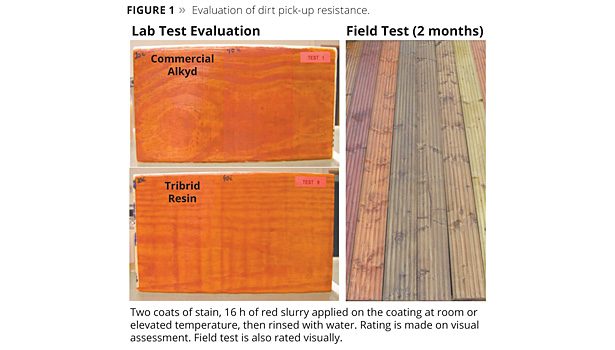
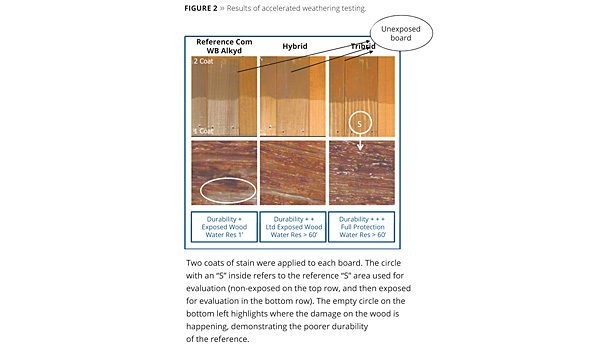
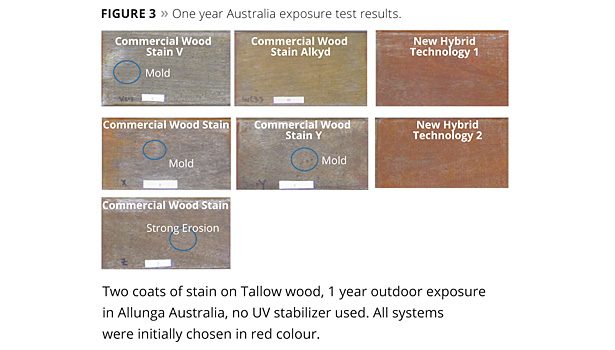
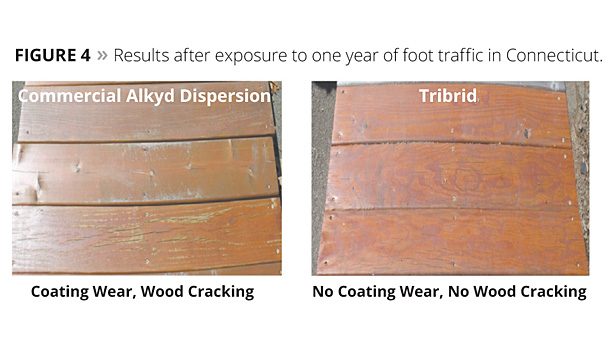
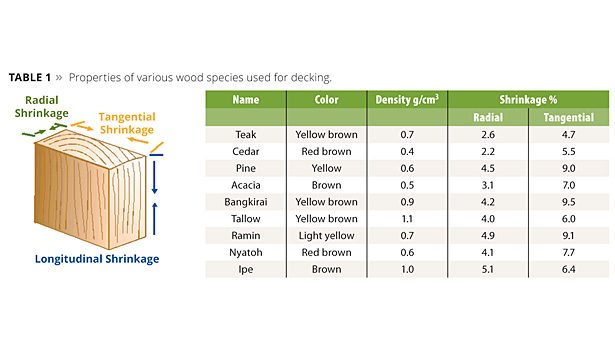
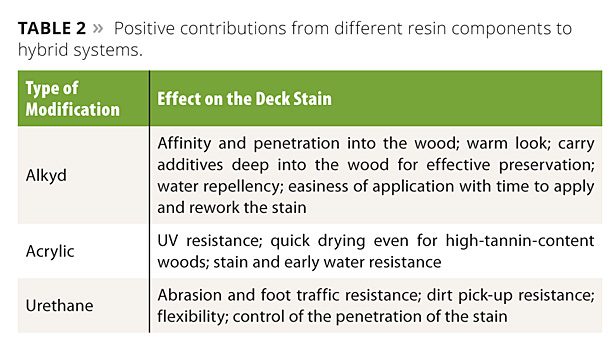
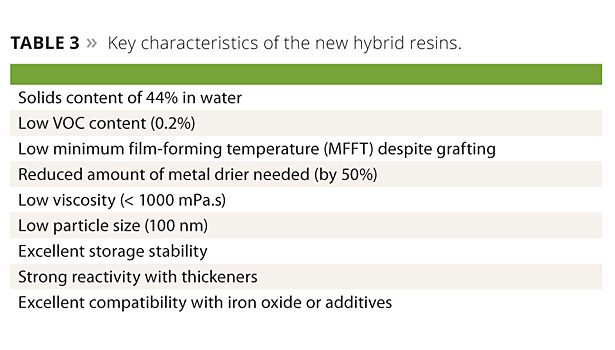
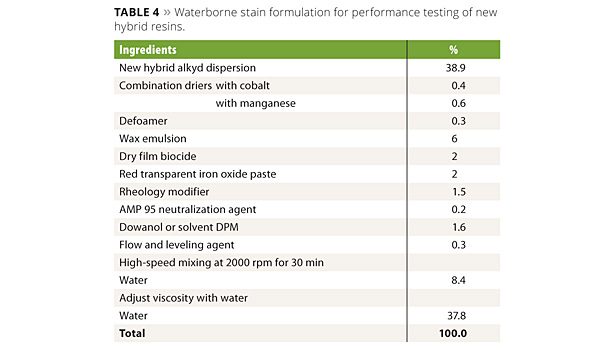
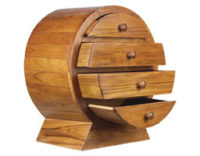
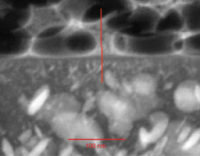


Report Abusive Comment